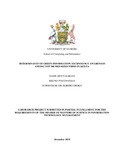| dc.description.abstract | This study sought to establish the determinants of Green IT awareness among Top 100 Mid-Sized Firms in Kenya. This study sought to achieve five specific research objectives: to establish the level of Green IT knowledge among Top 100 Mid-Sized Firms in Kenya; to identify the individual level determinants of level of Green IT awareness among Top 100 Mid-Sized Firms in Kenya; to determine the firm level determinants of level of Green IT awareness among Top 100 Mid-Sized Firms in Kenya; to establish external determinants of level of Green IT awareness among Top 100 Mid-Sized Firms in Kenya; and to establish the relationship among determinants of Green IT awareness among Top 100 Mid-Sized Firms in Kenya.
This study used descriptive survey design. The target population was mid-sized companies in all sectors in Kenya. The target of this study was the Top 100 Mid-Sized Firms as rated in 2014 KPMG and Nation Media Group survey. This study targeted employees and IT managers in the Top 100 Mid-Sized Firms. Simple random sampling method was used to select 30 ‗Top 100 Mid-Sized Firms‘ from the Top 100 Mid-Sized Firms in Nairobi year 2014. Convenient sampling was used to obtain 3 employees from each Top 100 Mid-Sized Firms selected for the study. Purposive sampling was used to obtain 30 IT managers of the selected from Top 100 Mid-Sized Firms. The sample size for the study was therefore 120 respondents. Three key informants from UNEP, NEMA and the Ministry of Information and Communication Technology each was purposively selected as policy makers in the sector. The key informants were therefore nine (9). Primary data and secondary data were collected. Primary data was collected through semi-structured questionnaires with both open and closed ended questions. Questionnaires were administered to each Top 100 Mid-Sized Firm addressed to the IT manager and to three employees. Quantitative data was analyzed using inferential statistics and descriptive statistics. The results of quantitative data analysis were presented in tables and figures. The study also used factor analysis to establish the key determinants of Green IT awareness. Qualitative data on the other hand was analyzed using content analysis. Results of qualitative data analysis were presented in descriptive narrative.
The results have shown that level of green IT awareness was positively correlated to individual level determinants (r=.365), firm level determinants (r=.285), external determinants (r=.390) and government policy (r=.305) at 99% confidence level. Additionally, the results have shown that individual level determinants positively and significantly affected level of Green IT awareness (β=.220, p=.022). Firm level determinants were found to positively affect level of Green IT awareness (β=.140, p=.065) but this relationship was not statistically significant. The results have also shown that external determinants positively and significantly affect level of Green IT awareness (β=.294, p=.003). This study has revealed that green IT awareness is low among mid sized firms in Kenya.
This study concluded that individual level, firm level and external determinants are important predictors of the level of green IT awareness in mid sized firms in Kenya. Individual level and external determinants are especially significantly influencing green IT awareness. Firm level determinants are not significantly influencing level of green IT awareness. This study recommends that the government and other stakeholders should come together to increase the level of green IT awareness. The government in raising level of green IT awareness should focus on individual level, firm level and external determinants as they have been revealed to positively
xi
influence level of green IT awareness. The mid sized firms in Kenya should give level of green IT awareness issue the priority and importance it deserves. Contrary, the situation as it is, level of green IT awareness issue is not a priority in mid sized firms in Kenya.
Keywords: Green IT, Carbon footprint, awareness, determinants | en_US |



